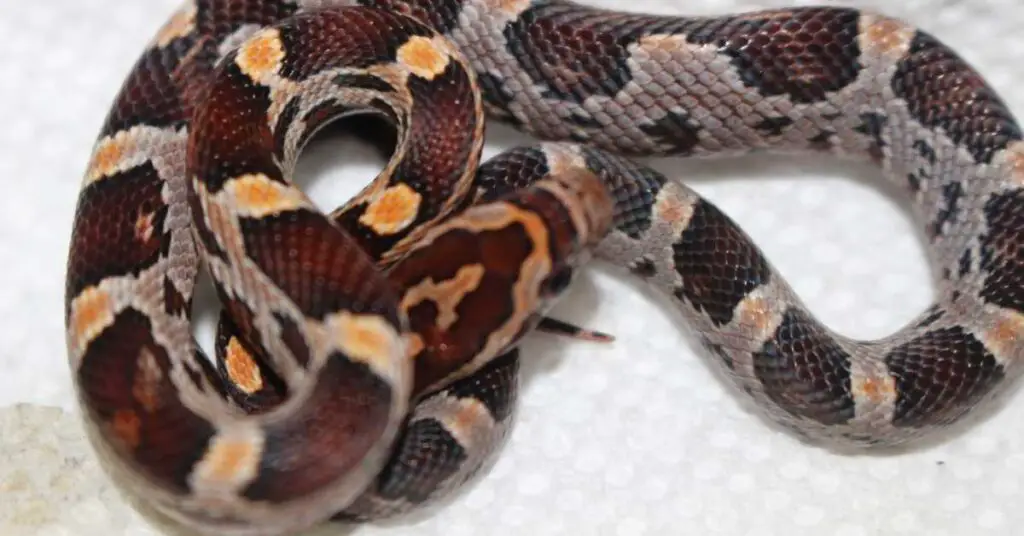Did you know that corn snakes, despite being cold-blooded reptiles, actually require heat to survive? While it may seem counterintuitive, these fascinating creatures rely on external heat sources to regulate their body temperature and carry out essential biological functions.
However, have you ever wondered if corn snakes could potentially survive without heat? It’s a question that has piqued the curiosity of many reptile enthusiasts, and in this discussion, we will explore the possibilities and implications of whether or not corn snakes can thrive in the absence of heat.
So, let’s dive deeper into this intriguing topic and uncover the truth behind the heat requirements of these captivating reptiles.
Key Takeaways
- Corn snakes rely on external heat sources to regulate their body temperature and exhibit natural behaviors within a specific temperature range.
- Heat is crucial for their behavior, feeding, and mating, and low temperatures can lead to decreased activity and feeding behavior.
- High temperatures can cause stress and dehydration, and heat is necessary for proper digestion and nutrient absorption.
- Signs of heat stress in corn snakes include increased hiding behavior, restlessness, rapid breathing, lethargy, and loss of appetite. It is important to monitor these signs to prevent harm to the snakes.
Natural Habitat and Temperature Requirements
In order to understand whether corn snakes can live without heat, it’s crucial to examine their natural habitat and the temperature requirements they’ve evolved to thrive in. Corn snakes are native to the southeastern United States, where they inhabit a variety of environments including forests, grasslands, and even farmlands.
These snakes are ectothermic, meaning that they rely on external sources of heat to regulate their body temperature. They’re most active and exhibit their natural behaviors within a specific temperature range.
Corn snake behavior is highly influenced by temperature changes. When the temperature drops, corn snakes become less active and seek out warmer areas to thermoregulate. Conversely, when the temperature rises, they may become more active and move towards cooler areas to avoid overheating. These responses help them maintain their internal body temperature within a suitable range for optimal functioning.
Temperature also plays a crucial role in the reproductive success of corn snakes. In order to breed, female corn snakes require a temperature drop, known as brumation, which mimics the colder winter months. This drop in temperature triggers hormonal changes that prepare the female for reproduction. Furthermore, the eggs laid by female corn snakes require a specific incubation temperature for successful development.

Importance of Heat for Corn Snake Survival
Considering the vital role that temperature plays in the natural behavior, reproductive success, and overall functioning of corn snakes, it becomes evident that heat is of utmost importance for their survival.
The effect of temperature on corn snake behavior is significant, as it directly influences their ability to carry out essential activities such as feeding, mating, and seeking shelter. Corn snakes are ectothermic, meaning they rely on external heat sources to regulate their body temperature. When the temperature is too low, their metabolism slows down, leading to decreased activity levels and reduced feeding behavior.
On the other hand, when the temperature is too high, corn snakes may become stressed and suffer from dehydration.
In addition to impacting behavior, temperature also affects corn snake digestion. These reptiles require a warm environment to properly digest their food. Without heat, their digestive system becomes sluggish, making it difficult for them to break down and absorb nutrients from their prey. This can lead to malnutrition and various health issues.
Moreover, the absence of heat can weaken their immune system, making them more susceptible to diseases and infections.
Signs of Heat Stress in Corn Snakes
Heat stress in corn snakes can be identified through a range of observable symptoms and behaviors. It’s important to be aware of these signs in order to prevent any harm to your pet. Here are four key indicators of heat stress in corn snakes:
- Increased hiding: When a corn snake is experiencing heat stress, it may seek out cooler areas to escape the excessive heat. This can manifest as increased hiding behavior, such as spending more time in their hideouts or trying to burrow into the substrate.
- Restlessness and pacing: Another sign of heat stress is increased restlessness and pacing. Corn snakes may exhibit repetitive movements or constantly try to climb the enclosure walls in an attempt to find a cooler spot.
- Rapid breathing: Heat stress can cause corn snakes to breathe more rapidly than usual. You may notice their sides heaving as they struggle to regulate their body temperature.
- Lethargy and lack of appetite: Heat-stressed corn snakes may become lethargic and lose their appetite. They may appear weak, uninterested in food, and show a lack of energy.
To prevent heat stress in corn snakes, it’s crucial to provide them with a suitable heat gradient in their enclosure that allows them to regulate their body temperature. Always provide a warm side and a cooler side, along with a thermostat to maintain the appropriate temperatures.
Additionally, ensure proper ventilation and monitor the ambient temperature to prevent any extremes that could lead to heat stress.
Alternatives to Traditional Heat Sources for Corn Snakes
To provide suitable heat for your corn snake, there are alternative options to the traditional heat sources commonly used in their enclosures. While heating lamps and ceramic heat emitters are commonly used, there are other artificial heating options that can be considered as well.
One alternative option is the use of heating pads. These pads are placed underneath the enclosure and provide a gentle and consistent source of heat. They’re particularly useful for creating a warm spot for your corn snake to bask in, as they emit heat from below. Heating pads come in various sizes and can be easily regulated using a thermostat to ensure the optimal temperature is maintained.
Another option is the use of heat tape. Heat tape is a thin, flexible strip that produces heat when an electric current passes through it. It can be adhered to the bottom or sides of the enclosure, providing a consistent source of heat. Heat tape is also compatible with thermostats, allowing for precise temperature control.
When using alternative heating options, it’s important to monitor the temperature closely to ensure it remains within the appropriate range for your corn snake’s needs. Always use a reliable thermometer to accurately measure the temperature in different areas of the enclosure.
Expert Tips for Maintaining Optimal Heat Levels
When maintaining optimal heat levels for your corn snake, it’s crucial to implement expert tips to ensure their well-being and comfort. Here are some key considerations to help you maintain the right temperature for your pet:
- Heat lamps vs. heating pads: pros and cons
- Heat lamps provide a concentrated heat source from above, mimicking the warmth of the sun. They can be beneficial for diurnal species like corn snakes, as they help regulate their circadian rhythm. However, they can also dry out the enclosure if not properly balanced with humidity levels.
- Heating pads, on the other hand, offer a gentle, constant heat from below. This can be beneficial for nocturnal species like corn snakes, as it mimics the warmth they’d seek in their natural burrows. However, they may not provide enough ambient heat for diurnal species.
- Creating a temperature gradient in the corn snake enclosure
- Corn snakes are ectothermic, meaning they rely on external heat sources to regulate their body temperature. It’s important to provide a temperature gradient within the enclosure to allow your snake to thermoregulate. This can be achieved by placing the heat source on one side of the enclosure, creating a warm basking area, while the other side remains cooler for your snake to retreat to when needed.
Frequently Asked Questions
How Can I Provide Heat for My Corn Snake Without Using Traditional Heat Sources?
To provide heat for your corn snake without traditional methods, consider alternative heat sources such as reptile heating pads or heat panels. Additionally, natural heating methods like using a ceramic heat emitter or creating a warm basking spot can be effective.
What Are the Signs of Heat Stress in Corn Snakes?
To prevent heat stress in your corn snake, it’s important to recognize the signs of heat exhaustion. These include excessive lethargy, rapid breathing, and seeking cool areas. Maintaining appropriate heat sources is crucial for their well-being.
Are There Any Alternatives to Using Heat Lamps or Heating Pads for Corn Snakes?
You may wonder if corn snakes can survive without heat, but there are alternative heating methods available. Natural heat sources like ceramic heat emitters and radiant heat panels can effectively provide the necessary warmth for your snake’s well-being.
Can Corn Snakes Survive Without Any Heat Source?
Yes, corn snakes can survive without a heat source, but it is not ideal. Being cold-blooded reptiles, they rely on external heat to regulate their body temperature through thermoregulation.
Are There Any Expert Tips for Maintaining Optimal Heat Levels for Corn Snakes?
To maintain optimal heat levels for your corn snake, it is crucial to create a heat gradient in their enclosure. Expert advice suggests using a combination of heating mats, ceramic heat emitters, and thermostats to regulate temperatures effectively.
Conclusion
In conclusion, corn snakes can’t live without heat as it’s vital for their survival. They require specific temperature ranges to maintain their metabolic functions and overall health.
Heat stress can have detrimental effects on corn snakes, leading to reduced appetite, weakened immune system, and even death.
It’s crucial to provide them with appropriate heat sources, such as heat pads or ceramic heaters, to ensure their well-being in captivity.
Always consult with experts for maintaining optimal heat levels for corn snakes.


